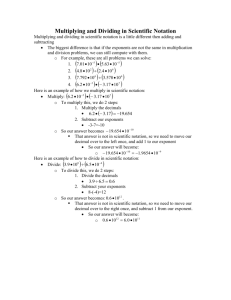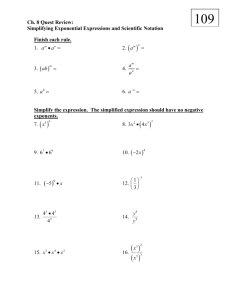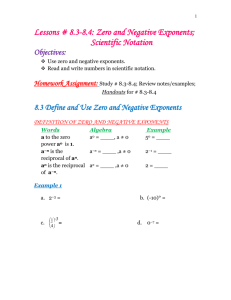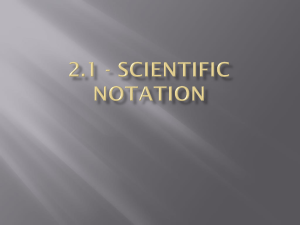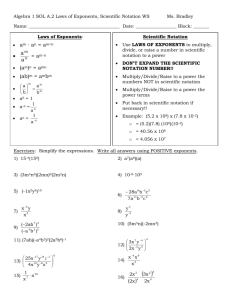Grade 8 Unit 1 – Integer Exponents And Scientific Notation (2014
advertisement
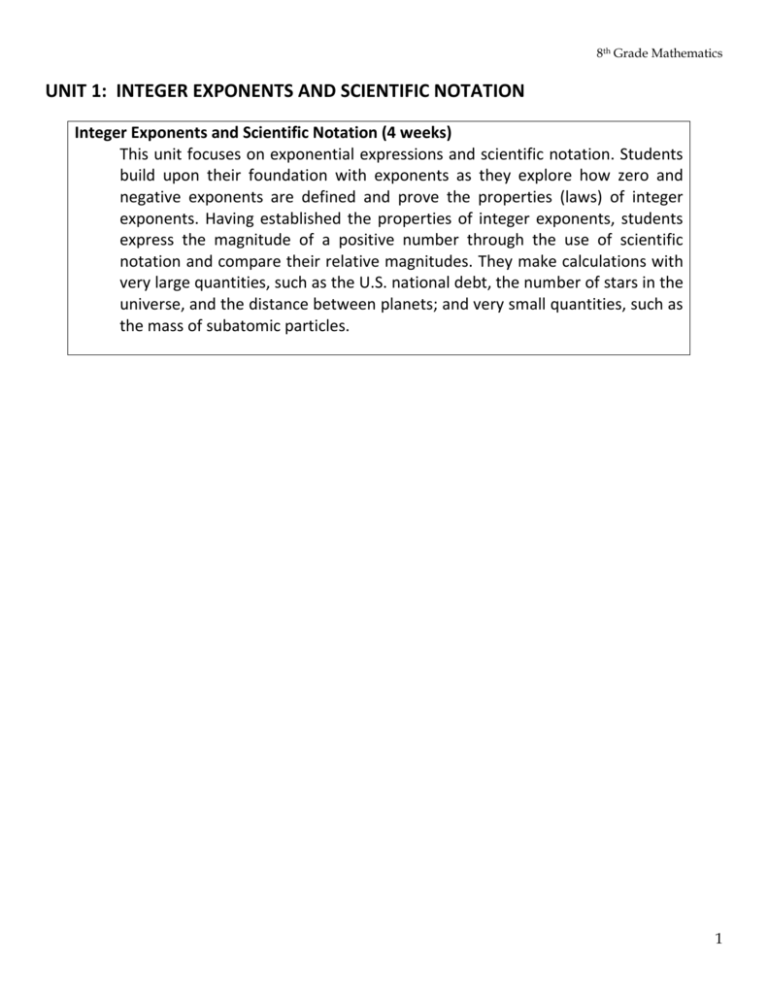
8th Grade Mathematics UNIT 1: INTEGER EXPONENTS AND SCIENTIFIC NOTATION Integer Exponents and Scientific Notation (4 weeks) This unit focuses on exponential expressions and scientific notation. Students build upon their foundation with exponents as they explore how zero and negative exponents are defined and prove the properties (laws) of integer exponents. Having established the properties of integer exponents, students express the magnitude of a positive number through the use of scientific notation and compare their relative magnitudes. They make calculations with very large quantities, such as the U.S. national debt, the number of stars in the universe, and the distance between planets; and very small quantities, such as the mass of subatomic particles. 1 8th Grade Mathematics Key Ideas: The exponent in an exponential term tells us how many times the base is to be multiplied. An exponent can have any value, positive or negative. The value of any number to the zero power is equal to one, except if the base is zero. The value of any number raised to a negative integer power can be expressed with either a negative exponent or the multiplicative inverse (reciprocal) of the number raised to the positive integer exponent. The inverse operation of any exponent is its root (i.e. the inverse operation of squaring a number is to take the square root) Positive powers of 10 are very large numbers, and negative powers of 10 are very small numbers. We can use scientific notation as a means of estimating and comparing very small and very large quantities. Guiding/Focus Questions: What is the relationship between a base and its exponent? How can we prove that x0 = 1 and 1 x-1 = ? x How can we prove that a. xa · xb = xa+b? xa b. = xa-b? xb c. (xa)b = xab? When a number is written in scientific notation, what do we notice about the relationship between the decimal places in the given number and the power of 10? How does scientific notation help us compare large and small quantities? 2 8th Grade Mathematics NYS Common Core Standards for Mathematics Focus Standards: Work with radicals and integer exponents. 8.EE.1 Know and apply the properties of integer exponents to generate equivalent numerical expressions. For example, 32 × 3-5 = 3-3 = 1/33 = 1/27. 8.EE.3 Use numbers expressed in the form of a single digit times an integer power of 10 to estimate very large or very small quantities, and to express how many times as much one is than the other. For example, estimate the population of the United States as 3 × 108 and the population of the world as 7 × 109, and determine that the world population is more than 20 times larger. 8.EE.4 Perform operations with numbers expressed in scientific notation, including problems where both decimal and scientific notation are used. Use scientific notation and choose units of appropriate size for measurements of very large or very small quantities (e.g., use millimeters per year for seafloor spreading). Interpret scientific notation that has been generated by technology. Foundational Standards(Prerequisites): Understand the place value system. 5.NBT.2 Explain patterns in the number of zeros of the product when multiplying a number by powers of 10, and explain patterns in the placement of the decimal point when a decimal is multiplied or divided by a power of 10. Use whole-number exponents to denote powers of 10. Apply and extend previous understandings of arithmetic to algebraic expressions. 6.EE.1 Write and evaluate numerical expressions involving whole-number exponents. Focus Standards for Mathematical Practice: MP.2 Reason abstractly and quantitatively. Students use concrete numbers to explore the properties of numbers in exponential form and then prove that the properties are true for all positive bases and all integer exponents using symbolic representations for bases and exponents. As lessons progress, students use symbols to represent integer exponents and make sense of those quantities in problem situations. Students refer to symbolic notation in order to contextualize the requirements and limitations of given statements (e.g., letting 𝑚, 𝑛 represent positive integers, letting 𝑎, 𝑏 represent all integers, both with respect to the properties of exponents). MP.3 Construct viable arguments and critique the reasoning of others. Students reason through the acceptability of definitions and proofs (e.g., the definitions of 𝑥0 and 𝑥−𝑏 for all integers 𝑏 and positive integers 𝑥). New definitions, as well as proofs, require students to analyze situations and break them into cases. Further, students examine the implications of these definitions and proofs on existing properties of integer exponents. Students keep the goal of a logical argument in mind while attending to details that develop during the reasoning process. 3 8th Grade Mathematics MP.6 Attend to precision. Beginning with the first lesson on exponential notation, students are required to attend to the definitions provided throughout the lessons and the limitations of symbolic statements, making sure to express what they mean clearly. Students are provided a hypothesis, such as 𝑥 < 𝑦, for positive integers 𝑥, 𝑦, and then asked to evaluate whether a statement, like −2<5, contradicts this hypothesis. MP.7 Look for and make use of structure. Students understand and make analogies to the distributive law as they develop properties of exponents. Students will know 𝑥𝑚∙𝑥𝑛=𝑥𝑚+𝑛 as an analog of 𝑚𝑥+𝑛𝑥=(𝑚+𝑛)𝑥 and (𝑥𝑚)𝑛=𝑥𝑚×𝑛 as an analog of 𝑛×(𝑚×𝑥)=(𝑛×𝑚)×𝑥. MP.8 Look for and express regularity in repeated reasoning. While evaluating the cases developed for the proofs of laws of exponents, students identify when a statement must be proved or if it has already been proven. Students see the use of the laws of exponents in application problems and notice the patterns that are developed in problems. Content Exponential Notation Numbers Raised to the Zeroth Power Negative Exponents Laws of Exponents Scientific Notation Operations with Scientific Notation Skills Simplify expressions with integer exponents Write equivalent numerical and symbolic expressions using the laws of exponents Express large and small numbers in scientific notation Estimate and compare numbers written in scientific notation Add, subtract, multiply, and divide numbers written in scientific notation Determine appropriate units for various measurements 4 8th Grade Mathematics Vocabulary/ Key Terms (with definitions and Spanish translations) Scientific Notation Order of Magnitude Exponential Notation Base, Exponent, Power Integer Whole Number Expanded Form (of decimal numbers) Square and Cube (of a number) Equivalent Fractions ASSESSMENT EVIDENCE Initial Assessment: Unit Readiness Test Formative Assessments: Quizzes Exit Slips Checks for Understanding Short and Extended-Response questions used throughout the unit. Mathematical Reflections Formative Assessments Tasks Performance Task 1 ( Properties of Exponents) Performance Task 2 (Scientific Notation) Summative Assessment/s: Unit Test 5 8th Grade Mathematics TEACHING PLAN Teaching and Learning Activities: I. Administer the Unit Readiness Test to assess students’ performance against the Foundational Standards. II. Use the guiding questions to focus each lesson. [Suggested instructional approach: Launch-Explore-Summarize] Lesson 1: Lesson 2: Lesson 3: Lesson 4: Lesson 5: Lesson 6: Lesson 7: Lesson 6: Lesson 7: Lesson 8: III. Exponential Notation Numbers Raised to the Zeroth Power Negative Exponents Product Laws of Exponents Multiplying Expressions with the Same Base Multiplying Expressions with the Same Exponents Quotient Laws of Exponents Dividing Expressions with the Same Base Dividing Expressions with the Same Exponents Numbers in Exponential Form Raised to a Power Scientific Notation Adding and Subtracting Numbers in Scientific Notation Multiplying and Dividing Numbers in Scientific Notation Efficacy of the Scientific Notation (NYS Common Core Module 1, Lesson 11) Assess students on the unit. Final Performance Task Unit Test Resources Needed: Connected Math Project 3 (CMP3): Growing, Growing, Growing NYS Common Core Math Module 1: Integer Exponents and Scientific Notation https://www.engageny.org/resource/grade-8-mathematics-module-1 Impact Mathematics Course 3 Integrated Algebra Math Handbook MathXL (Pearson’s online homework, tutorial, and assessment system) Glencoe New York State Review Series http://www.livebinders.com/play/play?id=953710#anchor http://www.algebrahelp.com/ 6 8th Grade Mathematics CALENDAR Time Spent Standards Topics To Cover Resources Needed Connected Math Project 3 (CMP3): Growing, Growing, Growing NYS Common Core Math Module 1: Integer Exponents and Scientific Notation https://www.engageny.org/resource/grad e-8-mathematics-module-1 Impact Mathematics Course 3 Integrated Algebra Math Handbook MathXL (Pearson’s online homework, tutorial, and assessment system) Glencoe New York State Review Series http://www.livebinders.com/play/play?id=9537 10#anchor http://www.algebrahelp.com/ 2 weeks 8.EE.1 Exponential Notation Zero and Negative Exponents Properties/Laws of Exponents 2 weeks 8.EE.3 8.EE.4. Scientific notation Operations with scientific notation 7

